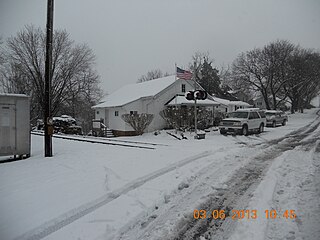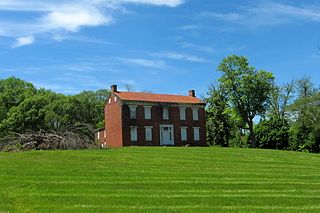The order of battle for the Third Battle of Winchester (also known as the Battle of Opequon or Battle of Opequon Creek) includes:

Frederick County is located in the Commonwealth of Virginia. As of the 2020 census, the population was 91,419. Its county seat is Winchester. The county was formed in 1743 by the splitting of Orange County. It is Virginia's northernmost county. Frederick County is included in the Winchester, VA-WV Metropolitan Statistical Area, which is also included in the Washington-Baltimore-Northern Virginia, DC-MD-VA-WV-PA Combined Statistical Area.
Battle of Winchester may refer to:

The Second Battle of Winchester was fought between June 13 and June 15, 1863, in Frederick County and Winchester, Virginia as part of the Gettysburg Campaign during the American Civil War. As Confederate Lieutenant General Richard S. Ewell moved north through the Shenandoah Valley in the direction of Pennsylvania, his corps defeated the Union Army garrison commanded by Major General Robert H. Milroy, capturing Winchester and numerous Union prisoners.

The Third Battle of Winchester, also known as the Battle of Opequon or Battle of Opequon Creek, was an American Civil War battle fought near Winchester, Virginia, on September 19, 1864. Union Army Major General Philip Sheridan defeated Confederate Army Lieutenant General Jubal Early in one of the largest, bloodiest, and most important battles in the Shenandoah Valley. Among the 5,000 Union casualties were one general killed and three wounded. The casualty rate for the Confederates was high: about 4,000 of 15,500. Two Confederate generals were killed and four were wounded. Participants in the battle included two future presidents of the United States, two future governors of Virginia, a former vice president of the United States, and a colonel whose grandson, George S. Patton, became a famous general in World War II.

The Valley campaigns of 1864 began as operations initiated by Union Lieutenant General Ulysses S. Grant and resulting battles that took place in the Shenandoah Valley of Virginia during the American Civil War from May to October 1864. Some military historians divide this period into three separate campaigns. This article considers them together, as the campaigns interacted and built upon one another.

Opequon Creek is an approximately 35 mile tributary stream of the Potomac River. It flows into the Potomac northeast of Martinsburg in Berkeley County, West Virginia, and its source lies northwest of the community of Opequon at the foot of Great North Mountain in Frederick County, Virginia. The Opequon forms part of the boundary between Frederick and Clarke counties in Virginia and also partially forms the boundary between Berkeley and Jefferson counties in West Virginia's Eastern Panhandle.
Kernstown is an unincorporated community within the independent city of Winchester, Virginia. Parts of Kernstown also lie within Frederick County. It is centered along the Valley Pike U.S. Route 11. During the American Civil War, the first and second Battles of Kernstown were fought here.
Abrams Creek is an 11.2-mile-long (18.0 km) tributary stream of Opequon Creek in Frederick County and the independent city of Winchester in Virginia. Abrams Creek rises north of Round Hill and flows in a southeasterly direction through Winchester. From Winchester, Abrams Creek flows east into Opequon Creek. The stream was originally known as Abraham's Creek.

The city of Winchester, Virginia, and the surrounding area, were the site of numerous battles during the American Civil War, as contending armies strove to control the lower Shenandoah Valley. Winchester changed hands more often than any other Confederate city.

Wadesville is an unincorporated community in Clarke County in the U.S. state of Virginia. Wadesville is located along Opequon Creek at Locke's Ford.
Opequon refers to several placenames in the Shenandoah Valley of Virginia and West Virginia, United States.
The following Union Army units and commanders fought in the Third Battle of Winchester in the American Civil War. The Confederate order of battle is listed separately. The battle was fought on September 19, 1864 near Winchester, Virginia, and Opequon Creek. The battle is also known as the Battle of Opequon or the Battle of Opequon Creek.
The 123rd Ohio Infantry Regiment, sometimes 123rd Ohio Volunteer Infantry was an infantry regiment in the Union Army during the American Civil War.

Henry W. Downs was a Union Army soldier serving in the 8th Vermont Volunteer Infantry Regiment during the American Civil War. He received the Medal of Honor for gallantry during the Battle of Opequon more commonly called the Third Battle of Winchester, Virginia on September 19, 1864.CITEREFSightline_Media_Group,Henry_W._Downs_(2020) He is buried at Dayton National Cemetery in Dayton, Ohio.
The following Confederate States Army units and commanders fought in the Third Battle of Winchester on September 19, 1864. The Union order of battle is listed separately. The battle was fought on September 19, 1864, near Winchester, Virginia, and Opequon Creek. The battle is also known as the Battle of Opequon or the Battle of Opequon Creek.

Millbank, also known as Spout Spring and Hillwood, is a historic house at 3100 Berryville Pike, in Frederick County, Virginia east of the city of Winchester. The two story brick mansion was built c. 1850 by Isaac and Daniel T. Wood. It is one of the largest Greek Revival houses in the county, standing on a hill overlooking Berryville Pike and Opequon Creek, which flows east of the property. The house has a typical I-house plan, with two entrances, one facing the highway and one the creek. Both were originally sheltered by Doric-columned porches, but the side entry's porch has been removed by vandals. The house was previously owned by the Winchester-Frederick Service Authority, who took the property in 1984 by eminent domain to construct the adjacent sewage treatment plant. It is now owned by The Fort Collier Civil War Center, Inc. (2014.) This nonprofit organization owns historic Fort Collier, another Third Battle of Winchester site.
Samuel or Sam Saunders may refer to:
The action at Abraham's Creek was an engagement on September 13, 1864 between Union Army and Confederate States Army forces during a Union reconnaissance in force toward Winchester, Virginia. The action occurred during skirmishing, maneuvering and scouting before the Third Battle of Winchester on September 19, 1864 in the Valley Campaigns of 1864 during the American Civil War. The Union force successfully completed the mission and captured about 173 Confederate prisoners.

Stonewall Confederate Cemetery is a subsection of Mount Hebron Cemetery in Winchester, Virginia, established in 1866 for 2,575 Confederate soldiers who died in battle or in the hospitals in and around the Winchester area. A monument over the mass grave of more than 800 unknown Confederate soldiers is at the center of the cemetery, and there is a section for each state member of the Confederacy. The plots are thus organized according to the home states of the fallen soldiers within. There are state monuments in most of the sections.